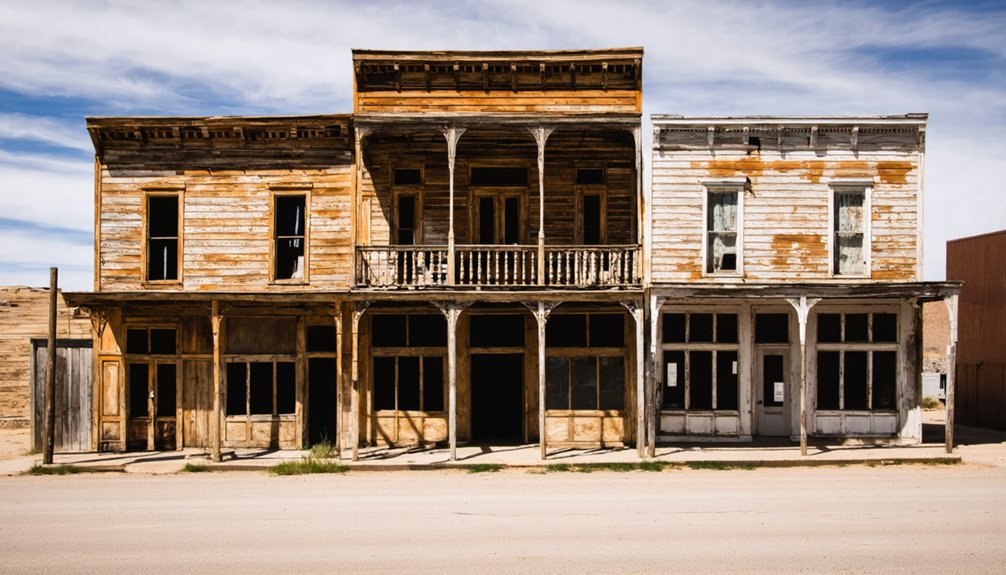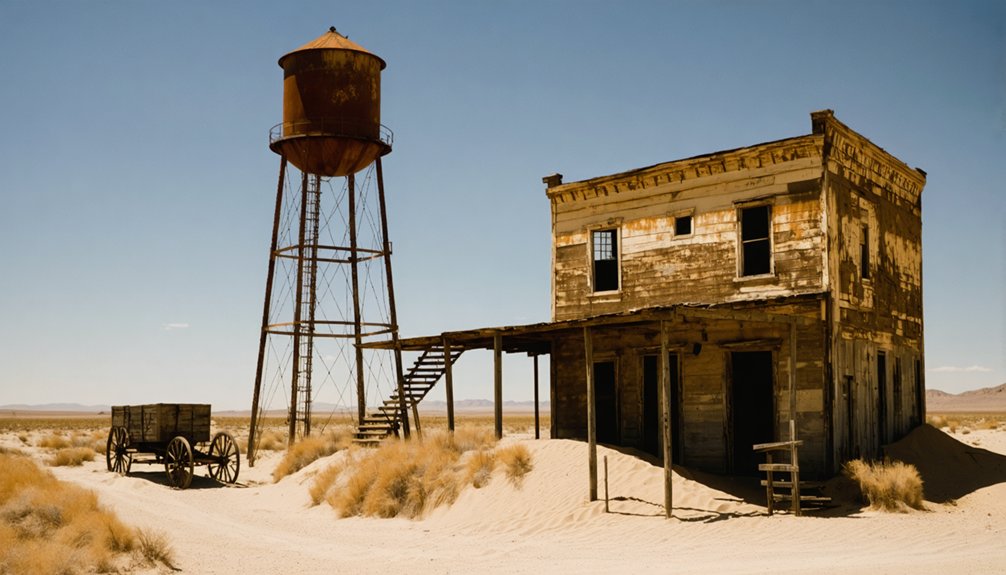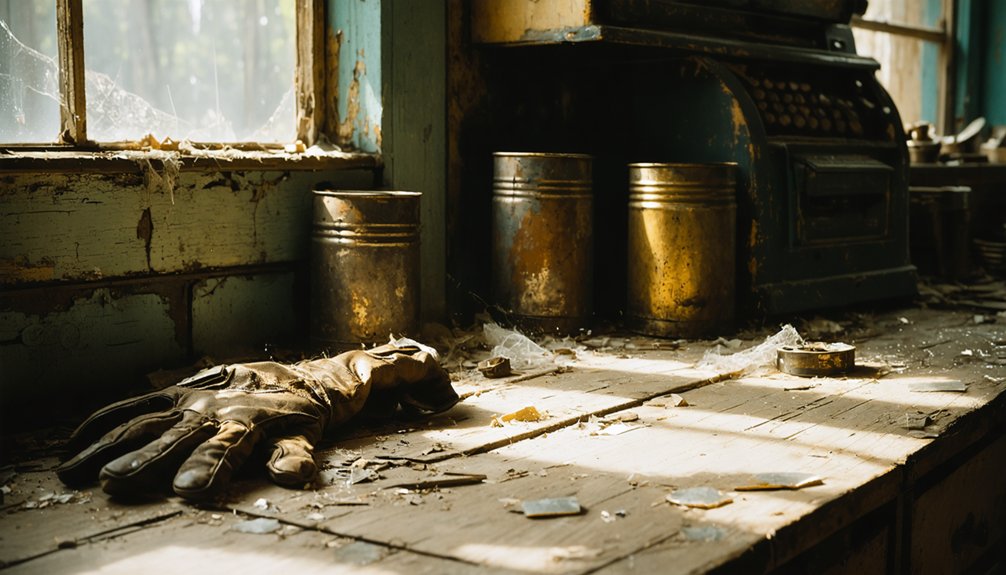Sloss (originally Calico) emerged after an 1881 silver discovery in California’s Sierra Nevada mountains. The boomtown quickly grew to nearly 1,200 residents with established governance structures and industrial mining operations. After silver yields declined in the 1910s, the community rapidly disbanded, leaving behind brick and concrete structures that now stand as protected ruins under California Historical Landmark status. The abandoned buildings and persistent legends of phantom mining crews continue to attract visitors seeking glimpses into America’s frontier past.
Key Takeaways
- Sloss was established in 1881 following silver discovery, growing to 1,200 residents during the mining boom of the mid-1880s.
- Originally called Calico, the town developed governance structures including a sheriff, courthouse, and judicial district during its prosperous years.
- Mining evolved from simple panning to industrial operations with hydraulic technology before economic decline began in the mid-1910s.
- Key preserved structures include the Mercantile Store, Schoolhouse, Post Office, and Blacksmith Shop with limited public viewing available.
- The ghost town attracts visitors with reported paranormal phenomena, including phantom mining crews and mysterious midnight machinery sounds.
The Rise of Sloss: Historical Origins
When silver was discovered in the surrounding mountains on April 6, 1881, it sparked the establishment of Sloss, originally known as Calico—a name inspired by the colorful rock formations prevalent in the area.
Four pioneering prospectors, including figures tied to San Bernardino County law enforcement, led early expeditions that established the Silver King Mine as the centerpiece of development.
As the settlement grew at its 2,283-foot elevation, the booming silver industry attracted nearly 1,200 residents by the mid-1880s.
The town quickly developed its own governance structure, including a sheriff, courthouse, and judicial district to manage the growing population.
Like many mining towns that dotted the California landscape, Sloss became a testament to human ambition etched into the mountainous terrain.
Miners employed sophisticated mining techniques including tunnel and drift mining, with some shafts extending over 500 feet into the mountainside.
The town derived approximately $86 million in silver during its productive years before government regulations led to its decline.
Mining Operations and Economic Boom
In the 1850s, you’d find Sloss miners initially using simple panning techniques before evolving to more sophisticated hydraulic mining operations that dramatically increased gold extraction volumes.
The economic prosperity from these mining advancements attracted significant investment in infrastructure, including stamp mills and water diversion systems that further enhanced production capabilities.
This unprecedented wealth creation ultimately proved unsustainable as accessible gold deposits diminished by the late 1870s, leading to the gradual abandonment of mining operations and initiating Sloss’s transformation into the ghost town you can visit today. Similar to Colonel James Withers Sloss’s contributions in Birmingham, these early mining operations were essential in transforming disorganized settlements into thriving communities with organized industrial infrastructure. Engineers who had worked on these hydraulic mining operations later transitioned their expertise to electrical transmission projects that helped develop California’s resources throughout the region.
Gold Rush Origins
The California Gold Rush transformed the sleepy settlement of Sloss into a bustling economic center after James W. Marshall discovered gold at Sutter’s Mill in January 1848. This momentous find sparked one of history’s largest migrations, with fortune seekers flooding into California’s goldfields, including the promising streams around Sloss.
Early gold discoveries near Sloss utilized simple mining techniques that evolved as surface gold diminished:
- Initial prospectors used pans and cradles to separate gold from stream sediment.
- As easy pickings disappeared, miners adopted more sophisticated long toms.
- Industrial operations later introduced hydraulic mining methods.
- Chinese miners continued traditional placer mining when excluded from larger operations.
The region’s economy exploded as merchants established trading posts where gold dust served as currency, supplying essential tools and provisions to the growing population of determined prospectors. By the 1860s, Sloss mining operations transitioned to more elaborate methods including water-driven pumps to access deeper gold-bearing deposits. The astounding gold output reached an estimated ten million dollars by the end of 1849, further driving development in the Sloss area.
Mining Technology Evolution
Mining technology in Sloss underwent dramatic evolution as surface gold disappeared, forcing prospectors to adopt increasingly sophisticated methods to access deeper deposits.
As traditional placer mining waned by 1854, miners turned to hydraulic techniques employing powerful monitors that blasted hillsides with up to 11,000 gallons of water per minute.
When environmental concerns curtailed hydraulic mining in 1884, technological advancements enabled new approaches.
Bucket-line dredges, mechanical charging equipment, and conveyor systems replaced labor-intensive mining methods, processing up to 1,500 tons of material daily. The arrival of the first bucket-line dredge in 1899 marked a turning point for mining operations in the region.
These innovations transformed Sloss’s economy, creating jobs while simultaneously reducing reliance on manual labor.
The progression from simple sluice boxes to industrial-scale operations reflected mining’s inevitable march toward mechanization, permanently altering both the landscape and economic structure of the region. Similar to how the Alaska Commercial Company adapted from fur trading to supply services during the Klondike Gold Rush, Sloss mining operations evolved with market demands.
Wealth and Decline
Founded in the early 1880s, Sloss Furnace Company transformed Jones Valley, Alabama into an industrial powerhouse by leveraging the region’s abundant natural resources. The economic impact was profound, with the extraction of iron ore, coal, limestone, and clay fueling unprecedented growth.
By World War I, Sloss-Sheffield ranked among the world’s largest pig iron producers.
You’ll appreciate how this mineral wealth reshaped the region:
- L&N Railroad’s $30 million investment created extensive transportation infrastructure
- Birmingham evolved from a rudimentary camp to a thriving industrial center
- Mining tonnage surpassed the entire U.S. cotton crop by 1888
- The Sloss family reinvested profits across diverse sectors
Similar to the abandoned mining towns of Shamong and Masonic, Sloss faced challenges that ultimately led to its decline.
Eventually, resource exhaustion and regulatory challenges contributed to decline, diminishing the cultural legacy of what was once a monument to industrial freedom and prosperity.
Daily Life in Sloss During Its Heyday
As Sloss reached its pinnacle during the late 19th century, daily life revolved primarily around the demanding rhythms of mining operations that dominated the town’s economy and social structure.
You’d witness miners working grueling shifts underground with rudimentary tools, while support workers maintained equipment and transported ore. Daily routines included hauling water from communal wells and heating homes with wood stoves in hastily built wooden structures.
Social interactions thrived despite hardships. After work, you’d find residents gathering in saloons for card games or attending community events. Women ran boarding houses or worked as laundresses. Like many communities that eventually became ghost towns, Sloss represented the interrupted dreams and abandoned hopes of those who sought fortune in the American West.
After day’s toil, Sloss residents found community through saloon gatherings, while women kept the social fabric intact through essential services.
Your diet would consist mainly of beans, potatoes, and preserved meats, with fresh produce being a luxury. The ever-present dangers of mining accidents, extreme weather, and limited medical care shaped the resilient character of Sloss’s inhabitants.
Key Buildings and Architectural Features

As you explore Sloss today, you’ll find remnants of industrial structures characterized by brick, steel, and concrete construction built to withstand extreme temperatures and heavy industrial use.
The town’s architectural hierarchy is evident: practical worker housing and basic community buildings contrast with the imposing furnaces and smokestacks that once dominated the skyline.
These surviving structural elements, including foundations, partial walls, and deteriorated industrial equipment, provide glimpses into the ghost town’s utilitarian design philosophy that prioritized function over aesthetic appeal.
Historic Structures Preserved
Several remarkable historic structures remain preserved in Sloss, offering visitors a genuine glimpse into California’s mining town past.
The ghost town architecture showcases wooden false-front facades, overhanging roofs, and exposed timber framing of historical significance. You’ll find original structures classified as abandoned sites per state criteria, yet protected under California Historical Landmark status.
Four must-see preserved buildings include:
- Sloss Mercantile Store with original facade, interior shelving, and display cases
- Schoolhouse featuring intact wooden frame, desks, and chalkboards
- Post Office complete with original signage, mail slots, and sorting tables
- Blacksmith Shop where the forge, anvil, and tool racks remain in place
These buildings remain open for limited public viewing and educational tours.
Construction Styles Found
Distinctive architectural elements throughout Sloss showcase the town’s evolution from simple mining camp to established community.
You’ll notice the predominance of vernacular architecture, with timber construction forming the backbone of most structures. Hand-hewn lumber joined with square nails characterizes the earliest buildings, while stone foundations provide durability to longer-standing establishments.
Main Street reveals practical false-front facades on commercial buildings, creating an illusion of grandeur despite their modest construction.
Victorian details occasionally appear on more prosperous homes, though function typically trumps form throughout the settlement. The practical gabled and shed roofs, often covered with metal for fire resistance, speak to the pragmatic needs of frontier life.
Double-hung windows and heavy plank doors with iron hardware complete the utilitarian aesthetic that defined this once-thriving mining community.
Prominent Figures and Families of Sloss
While historical records about Sloss, California remain sparse in mainstream documentation, this ghost town‘s social fabric was likely shaped by pioneering families who established themselves during the town’s development.
Current historical archives don’t provide specific information about the prominent families and notable figures who once called Sloss home.
To properly document Sloss’s social history, you’ll need to:
To uncover Sloss’s forgotten narrative, meticulous research through historical records and personal artifacts becomes essential.
- Consult county historical societies for family records and genealogical information
- Review land ownership documents and mining claims from the period
- Examine newspaper archives from neighboring towns that might mention Sloss residents
- Search for personal diaries, letters, or photographs preserved by descendants
Unlike better-documented ghost towns like Bodie or Calico, Sloss’s human story remains largely untold, awaiting discovery through deeper historical research.
The Decline: What Led to Abandonment

The once-bustling town of Sloss met its demise through a classic boom-and-bust pattern that has claimed countless mining settlements across the American West.
When gold yields began declining in the mid-1910s, the economic factors that had sustained Sloss quickly unraveled. The mine closure triggered a devastating chain reaction: unemployment soared, businesses shuttered, and essential services vanished.
You’d have witnessed the rapid disintegration of community dynamics as residents fled in search of work. With no alternative industries to replace mining revenue and challenged by the region’s harsh climate and isolation, Sloss couldn’t sustain itself.
The remote, arid location with limited water access further accelerated abandonment. By the 1930s, social cohesion had completely collapsed, leaving behind only abandoned structures—silent monuments to prosperity’s temporary nature.
Remaining Structures and Ruins Today
As you survey Sloss today, a stark contrast emerges between its once-vibrant existence and current state of natural reclamation. The site, now managed by the Bureau of Land Management as part of the Headwaters Forest Reserve, reveals minimal evidence of its past as a logging community.
Among the few remaining structures:
Time and forest have consumed Sloss, leaving only scattered remnants to whisper its industrial past.
- The caretaker’s cottage stands as one of the only surviving residential buildings.
- The old railroad roundhouse persists as a key industrial remnant.
- Scattered foundational remains lie hidden beneath dense vegetation.
- The railroad-related infrastructure offers glimpses into the town’s logging past.
Dense redwood growth has reclaimed most of the town, with former wooden homes, cookhouses, and mill buildings having succumbed to nature or deliberate removal by 1979 due to liability concerns.
Legends and Ghost Stories From Sloss

If you’re exploring Sloss at night, you’ll likely encounter reports of phantom mining crews who allegedly continue their labors long after the town’s abandonment.
Local folklore suggests that visitors have heard the distinctive sounds of mill machinery operating at midnight, despite the equipment being removed decades ago.
These ghostly manifestations are believed by paranormal enthusiasts to represent the restless spirits of miners who perished in the dangerous working conditions that characterized Sloss during its operational years.
Phantom Mining Crews
Legends of phantom mining crews haunt the abandoned landscape of Sloss, California, creating an atmosphere of supernatural mystery that persists to this day.
These spectral sightings typically occur at dawn or dusk, when shadowy figures in period mining attire emerge from abandoned shafts.
Historical records confirm multiple mining accidents at Sloss during the late 1800s, providing factual basis for these ghostly apparitions.
Witnesses consistently report:
- Silent figures carrying lanterns or mining tools
- Sounds of pickaxes and shovels echoing through empty mines
- Shadowy workers who vanish when approached
- Flickering lights moving through hillsides where no living person walks
These phenomena attract paranormal investigators and freedom-seeking adventurers alike, drawn to experience the unfinished business of miners whose spirits remain bound to their eternal work site.
Midnight Mill Sounds
While phantom miners haunt the daylight hours, the abandoned mill structures of Sloss take on a different supernatural character after dark.
Unfortunately, detailed accounts of the midnight mill sounds at Sloss, California remain elusive in the historical record. Current documentation lacks specific information about ghostly echoes that might reverberate through the ruined mill structures or spectral whispers that visitors have reported.
To properly document these phenomena, additional research from local historical societies, firsthand accounts, and regional folklore collections would be necessary.
For those seeking freedom to explore these mysteries yourselves, this gap in recorded history presents an opportunity for original investigation. The absence of documented midnight phenomena invites curious paranormal enthusiasts to conduct their own research into what sounds might emerge when darkness falls over Sloss’s abandoned industrial remains.
How to Visit: Location and Access Information
Located in the rugged terrain of Mariposa County, California, Sloss Ghost Town sits at approximately 35°55′16″N 117°54′10″W within the Sierra Nevada region.
This remote historical preservation site requires preparation before your visit. You’ll need to travel through Mariposa’s mountainous areas, with access routes often demanding high-clearance vehicles.
For successful ghost town tourism, follow these essential guidelines:
- Check road conditions and obtain necessary permissions, as Sloss may be on private property.
- Bring adequate supplies—no visitor facilities exist onsite.
- Download offline maps, as cell coverage is unreliable.
- Plan your visit during dry seasons, as winter weather can restrict access.
Mariposa serves as your primary staging point, with travel time to Sloss ranging from 30-60 minutes depending on conditions.
Preservation Efforts and Historical Recognition

Unlike many California ghost towns that have fallen into complete ruin, Sloss has benefited from strategic preservation initiatives that balance historical integrity with environmental concerns.
While not yet receiving state historical landmark status comparable to Calico’s designation (#782), preservation efforts rely heavily on volunteer engagement and community-driven stewardship.
The town faces significant preservation challenges, including structural decay and potential looting—activities now classified as felonies to protect the site’s historical significance.
Unlike Bodie’s “arrested decay” approach or Calico’s restoration under Walter Knott, Sloss employs a hybrid preservation model combining limited private ownership of structures while maintaining public access to the land.
This collaborative management between preservation-minded volunteers, local historians, and oversight agencies helps maintain authentic architectural elements while educating visitors about California’s mining heritage.
Frequently Asked Questions
Was Sloss Ever Featured in Movies or Television Shows?
No, you won’t find Sloss in any films or documentaries. Records show no major or independent productions have ever used the California ghost town as a filming location.
What Natural Disasters Affected Sloss Throughout Its History?
You’d find Sloss was markedly impacted by the Great Flood of 1862, which submerged it under nine feet of water. Earthquake damage likely compounded its vulnerability, hastening the town’s eventual abandonment.
Are There Any Annual Events Celebrating Sloss’s Heritage?
Like scrolling through Instagram in 1910, you’ll find no heritage festivals or community gatherings celebrating Sloss’s history today. Historical records don’t indicate any recurring commemorative events for this California ghost town.
What Indigenous Tribes Occupied the Sloss Area Before Settlement?
You’ll find the Sloss area was primarily inhabited by the Amah Mutsun Tribal Band and Ohlone people, whose rich cultural heritage included environmental stewardship before European colonization disrupted their Native tribes’ territories.
Can Artifacts From Sloss Be Found in Museums Today?
Like buried treasure brought to light, you’ll find Sloss artifacts preserved in regional museums like Silver City Ghost Town, where meticulous museum exhibitions showcase mining tools and domestic items from California’s forgotten settlements.
References
- https://la.curbed.com/2018/2/13/16968220/ghost-towns-desert-california-city-calico
- https://whimsysoul.com/must-see-california-ghost-towns-explore-forgotten-histories/
- https://www.savetheredwoods.org/blog/spooky-redwoods-ghost-town-remains-a-presence/
- https://www.youtube.com/watch?v=bz6XtozCSMg
- https://www.visitcalifornia.com/road-trips/ghost-towns/
- https://parks.sbcounty.gov/opinion-beyers-byways-a-brief-history-of-calico-ghost-town/
- https://en.wikipedia.org/wiki/List_of_ghost_towns_in_California
- https://www.youtube.com/watch?v=tZUFjHR3qpw
- https://main.sbcounty.gov/2025/05/29/san-bernardino-county-history-calico-ghost-town/
- https://capitolmuseum.ca.gov/state-symbols/silver-rush-ghost-town-calico/



